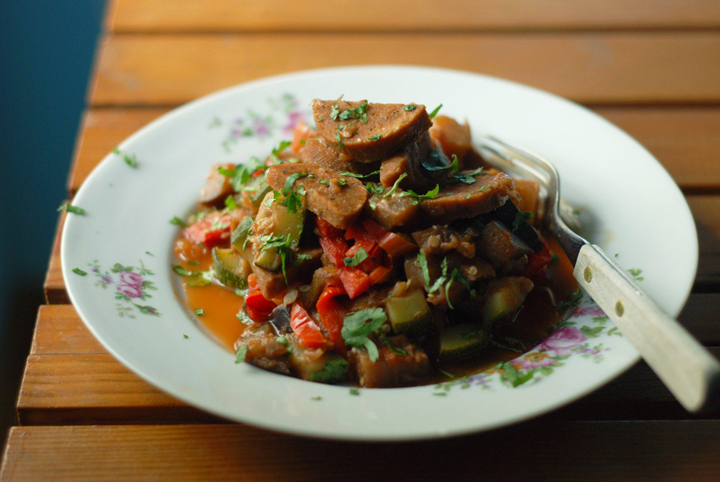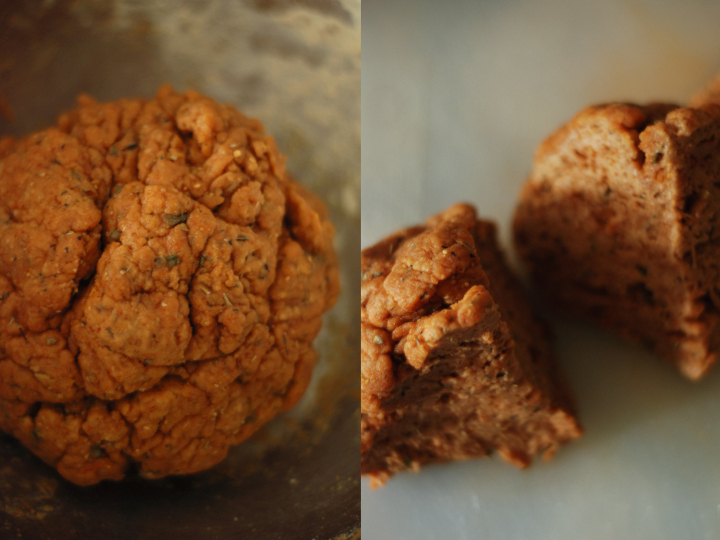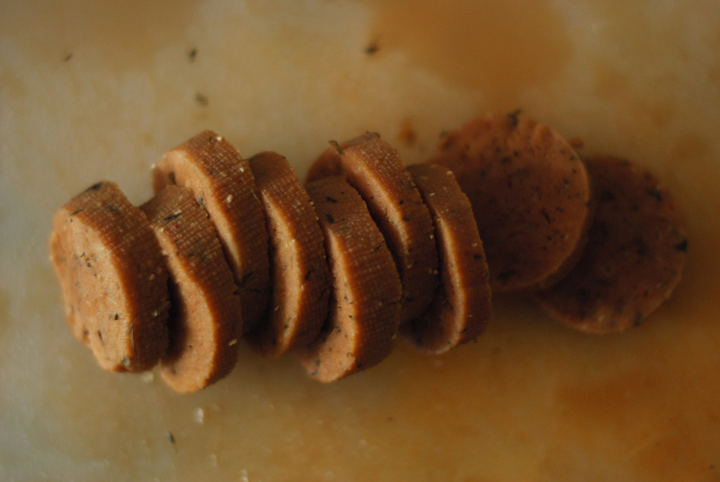Chickpea and Aubergine Falafel
For a dinner I was invited to on Saturday, I made falafel. Falafel is like the kind of food I’m almost sure every vegetarian on earth has tasted at least once in his/her lifetime. It’s also one of the things I always end up eating every time I travel. However, I had several bad experiences when I tried to make these spiced chickpea balls at home – most of the times, the falafels wouldn’t hold together and consequently fall apart while cooking. This time around I approached the recipe in a different way though – instead of canned chickpeas, I used dried ones, which made all the difference in terms of structure. I also added grilled aubergines to the mixture to provide some depth in terms of flavour. When it comes to falafel, I like it fried more than baked, even though the latter method of cooking is clearly healthier than the former. If you’d rather have it baked, go ahead – just bare in mind the balls won’t be as crispier as if they were fried, even though that comes with the huge advantage of cutting down a bunch of extra calories. Also, frying is, at least for me, a bit of a scary technique – whenever I fry something (which I do rarely), I’m always afraid of getting burnt by the hot oil, so I keep this safety distance from the pan/pot in which things are being fried, and then when I finally decide to turn them over it’s usually too late and they’re already burnt. Anyway, for this post I tried to fry the falafels and the whole process went extremely well – the fact that they were quite firm (I let them sit a few hours in the fridge), has probably contributed to the success. I’ll leave you with this recipe then, but not without the promise of a soon come back.
Chickpea and Aubergine Falafel
(makes about 25 medium sized falafel)
Ingredients:
1 ½ cups (300 g) dried chickpeas
2 tablespoons cumin seeds, crushed
1 tablespoon coriander seeds, crushed
1 big handful coriander (aprox. 7 g)
1 big handful mint (aprox. 12 g)
1 garlic clove, minced
1 teaspoon baking soda
¼ cup regular flour
¾ teaspoon salt
zest and juice of one lemon
2 medium sized aubergines (aprox. 580 g), cut into rounds of about 0.7 cm each
olive oil for frying or baking
1. Put the dried chickpeas in a large bowl and add enough water to cover. Let them soak overnight or for at least 8 hours before using. The day after, drain the chickpeas and wash them thoroughly under cold running water.
2. Now it’s time to salt the aubergine slices: put them in a large tray and add 2 to 3 tablespoons of salt. Leave them like that for at least 30 minutes – you’ll notice they’ll release some liquid and feel softer to the touch. Then, rinse the slices, wash them thoroughly and dry them with the help of a clean kitchen towel.
3. Add chickpeas and all the other ingredients, except the aubergines, to a food processor, and process everything until a thick paste comes together. Transfer the chickpea mixture to a large bowl and set aside.
4. In a large and lightly oiled grilling pan over medium/high heat, cook the aubergines’ slices for about 3 minutes on each side, or until they’re slightly browned or have grilling marks. When the slices are cool enough to handle, cut them into small pieces and add them to the chickpea mixture.
5. Shape the chickpea mixture into medium-sized balls and line them on a baking sheet. Refrigerate for at least 3 hours – the falafels should be cold and firm; if they’re not, let them sit in the fridge for a little longer.
6. Now, you can either fry or bake the falafels. If you want to fry them, heat about 5 cm (2 inches) of oil (I used olive oil) to aprox. 180 C (350 F) in a deep pan or pot. Add the falafels in small batches and fry them for 4 to 6 minutes or until golden brown. Transfer the falafels to a plate covered with paper towels to drain the excess oil. If you prefer to have them baked, brush the balls with olive oil and bake them in the oven (180 c / 350 F) for 15 minutes or until golden brown, turning halfway through for even browning.
7. Serve the falafels in pita bread with some yoghurt-based (I used a soy-based vegan yoghurt) sauce, chopped tomatoes, avocados and salad leaves.
Simple Vegetable Stew with Homemade Seitan Sausage
Seitan used to be one of those things I’d eat on rare occasions, as I was never a big fan of its taste. I liked its meaty, slightly chewy texture, but I felt I never marinated or seasoned it the right way, as everytime I’d prepare it, it would end up tasting a bit too bland. The only way I could eat this source of vegetable protein would be on a spaghetti bolognese sort of dish, where I’d grind it and cook it in unreasonable amounts of tomato sauce. But then I’ve bought The Millenium Cookbook and I found out I could make my own seitan, and add to it as much flavor as I wanted to. The original recipe from the book, has curry and spices such as cumin and coriander as dominant flavors. I’ve made that recipe a hundred times around here, until I started playing around with it a bit more. The recipe for the seitan sausages I’m sharing with you today, has dried herbs and tomato sauce as “flavoring agents”, to make it more of a provençal-inspired sort of thing.
As far as the preparation goes, let me tell you that seitan making has no special technique at all, and I’m sure that if you attempt at making it, you’ll be surprised by how easy it is. On the other hand, I bet that by the time you’re preparing it, you’ll have a lot of other ideas on how to flavor it differently. I’ve made a couple of notes on that too: adding seaweeds such as dulse or wakame to the gluten dough could be interesting, as well as finely cut vegetables, for a more distinct texture. On the same hand, I bet that adding a coulpe of drops of liquid smoke to the dough, would definitely please even the most conservative meat eaters out there. I added the sausages today to this simple vegetable stew, but feel free to try these in pasta sauces, pizzas, or in whatever dish you might think they’re a good addition to. The possibilities are endless, really, and I’m sure you can come up with better ideas for using it than I do. ; )
Update: Trudy, from VeggieNumNum, has made a wonderful version of these seitan sausages. You can find her version, as well as other stunning veggie recipes here.
Simpe Vegetable Stew with Homemade Seitan Sausage
For the Seitan Sausage
(makes 4 sausages)
2 cups (250 grams) gluten flour
1 teaspoon salt
2 fat garlic cloves, minced
1 large white onion, cut in half
¼ cup olive oil
1 cup water
4 cups light stock
3 tablespoons tamari
4 tablespoons tomato paste
1 teaspoon dried thyme
1 teaspoon dried oregano
1 teaspoon dried chives
1 teaspoon dried parsley
1 teaspoon garlic powder
½ teaspoon paprika
4 pieces of cheesecloth of 30×30 cm each (note: make sure the holes of your cheesecloth are very close. otherwise, you might have to double or triple the amount of cloth used)
1. In a large bowl, combine the gluten flour, dried herbs, garlic powder, and salt.
2. In another bowl, mix 1 cup of water with the olive oil, tomato paste, and 1 tablespoon of the tamari.
3. Slowly add the wet mixture to the dry mixture, and mix until you have a firm and elastic dough. Kneed the dough for 5 minutes, making sure there’s no flour left on the bowl.
4. Divide the dough into 4 equal portions. With your hands, roll out each portion into a log about 8 centimeters long, but don’t worry if it doesn’t look perfectly shaped - while cooking, the sausages will plump and get a perfect cilindric shape.
5. Cut 8 pieces of kitchen twine of about 6 centimeters long each. Place a piece of cheesecloth in your table or kitchen counter, and roll it tightly around one piece of the dough. Tie the ends of the sausage with kitchen twine (using one of the cut pieces for each end), to seal the sausage in the cheesecloth - it’s important that the dough is really tight and properly sealed, or it might fall apart while cooking. Repeat this proceeding with the remaining pieces of dough.
6. In a large pan, add the 4 cups of stock, garlic cloves, onion, and 2 tablespoons of the tamari, and bring the liquid to a boil. Then, add the sausages. Reduce the heat to low-medium and simmer, covered, for 40 to 45 minutes, or until the sausages are cooked through. Discard the onion and garlic cloves.
7. Remove the sausages from the pan, let them cool, and carefully remove the cheesecloth. The sausages will keep, stored in an airtight container with the cooking liquid, for up to 1 week.
For the Vegetable Stew
(serves 4, generously)
1 large aubergine, cubbed
1 large zucchini, cubbed
1 medium sized red bell pepper, thinly sliced
2 fat garlic cloves, minced
1 tablespoon coriander seeds
2 teaspoons red chili pepper, minced (with seeds)
1 large ripe tomato, peeled, seeded, and cubbed
1 and ½ seitan sausages (about 200 grams), sliced into rounds
2 tablespoons olive oil
¼ cup red wine
4 tablespoons tomato sauce (canned is fine)
salt and pepper to taste
chopped coriander, for garnish
1. With the help of a mortar and pestle, crush the coriander seeds.
2. Heat the olive oil in a large pan over medium heat, add the garlic, chilli, and coriander seeds, and fry for 1 to 2 minutes, or until fragrant.
3. Add the zucchini, aubergine, and tomato cubes, as well as the wine and tomato sauce, and simmer, covered, for 15 to 20 minutes, or until the vegetables are soft and slightly overcooked. Add the seitan sausage, give the stew a good stir, and cook for additional 5 minutes.
4. Add salt and pepper to taste and serve immediately, garnishing each serving with chopped coriander.
The recipe for the homemade seitan sausages is inspired by the Millenium Cookbook, published by 10 speed press, in 1998



5 comments